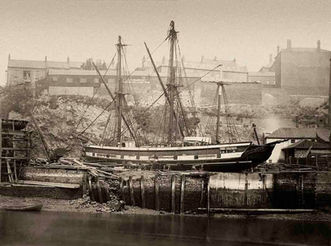SUN028
Wear
Monkwearmouth
Bridge Dock
Sunderland
54.910291, -1.383829
Useful Links:
Opened:
1804
Closed:
1936
Owners:
John Laing, Philip Laing (1804 - 1818), George Hall (1822 - 1862), James Hall (1822 - 1831), George Peverall (1863 - 1866), Robert Thompson & Sons (1881 - 1933), Wear Commissioners (1936)
Types built here:
Customers (Not Exhaustive):
Estimated Output:
112
Construction Materials:
Wood, Iron
Status:
Partly Preserved
Created:
Last Updated:
30/04/25
12/06/25
Description
The brotherly partnership of John & Philip Laing first operated at the North Sands, but leased (or built themselves) a dry dock on the north bank of the Wear. This was constructed just after the first iron Wearmouth Bridge, henceforth providing its name. In 1805 they made the full move from the North Sands to this site while both living on Church Street (next to St Peters).
By this time they were the most industrious shipbuilders, though this doesn't detract from their conservative lives. Like most shipbuilders in the early 19th century life was precarious, and perhaps in part due to their religious principles they lived austerely without frolic. SearleCanada notes they only had one decent pair of trousers between them (https://www.searlecanada.org/sunderland/sunderland061.html).
The Laing's also constructed the first floating dock on the Wear. This was produced out of an old Man-of-War, which was hollowed out into its timbers, to allow a basic platform to repair vessels.
We know little of the ships they built. We're aware of at least 30 produced between 1805 and 1816 at the yard - most being brigs and snows but the occasional barque was produced as well. The Kent, produced in 1814, was the first to feature chain cables rather than hemp rope. Most were for general cargo but some ended up on the tea trade like the Caledonia .
The partnership ended in 1818 as Philip opted out of the partnership. The firm was carried on by John Laing and James Laing, his son, over on the south west corner of Southwick opposite Pallion. Philip re-established himself at Deptford in 1819.
The Bridge Dock, though modest in shape and size, continued on as a shipyard. It was later occupied by a Mr George Wilkin Hall and James Hall from around 1822 until 1831, with George taking majority mantle from this year until 1862. James was the father and George the son born at Monkwearmouth Shore in 1806, and the family profession was very successful. Over the course of their tenure they constructed around 80 ships here. They continued to operate the wet dock, floating dock as well as providing repair operations as the Laing's did.
Their time here is also the first we can see on the maps. The yard, crammed between the bridge and the Sheepfold Lime Works, featured the gracing dock and an engine house, smithy, sawmill, saw pit and offices at the rear of the site. Access was gained via a series of steps from the top to the bottom of the bridge unless you fancied walking up the steep slope of Sheepfolds. There was also a quay with three separate cranes.
It's understood George Peverall also operated the yard here, from around 1863 until 1866. He previously had a yard at Wreath Quay, next to the Wearmouth Drops, but took on this site after the Hall's vacating. George was born t Durham in 1825 but a ship & insurance broker at Bishopwearmouth by the 1850s. He employed 20 men and boys here and constructed around 10 ships. This includes the most notable Pak Wan, a fully rigged schooner (then barque) which ended up on the trade to Australia moving tea and wool. It appears operations ceased here after only a few years, with the family moving down to London for new pastures.
The yard remained vacant for many years until Robert Thompson & Sons extended and rebuilt the dock and yard into a fully fledged late 19th century graving dock. Their work here was in operations from 1881 until 1933. It was primarily used for repair, but a minority of ships were built here. Given they also built from Southwick and the North Sands it's quite difficult to unpick how many vessels were constructed here, so I've given a conservative figure of 20 to the total.
The final owners of the Bridge Dock were the Wear Commissioners, who acquired it for river development. A piece in the Sunderland Echo of 20/11/1936 states it would use the site for widening of the river and were to sell all the buildings, machinery and dock gates. The engineering structures were sold off the the dock basin actually remained, and partly still does. It simply just silted up but has been partially infilled today. The East and west wall of the dock remain exposed.


Ordnance Survey, 1859
Have we missed something, made a mistake, or have something to add? Contact us
Historic Environment Records
Durham/Northumberland: Keys to the Past
Tyne and Wear: Sitelines
HER information as described above is reproduced under the basis the resource is free of charge for education use. It is not altered unless there are grammatical errors.
Historic Maps provided by








